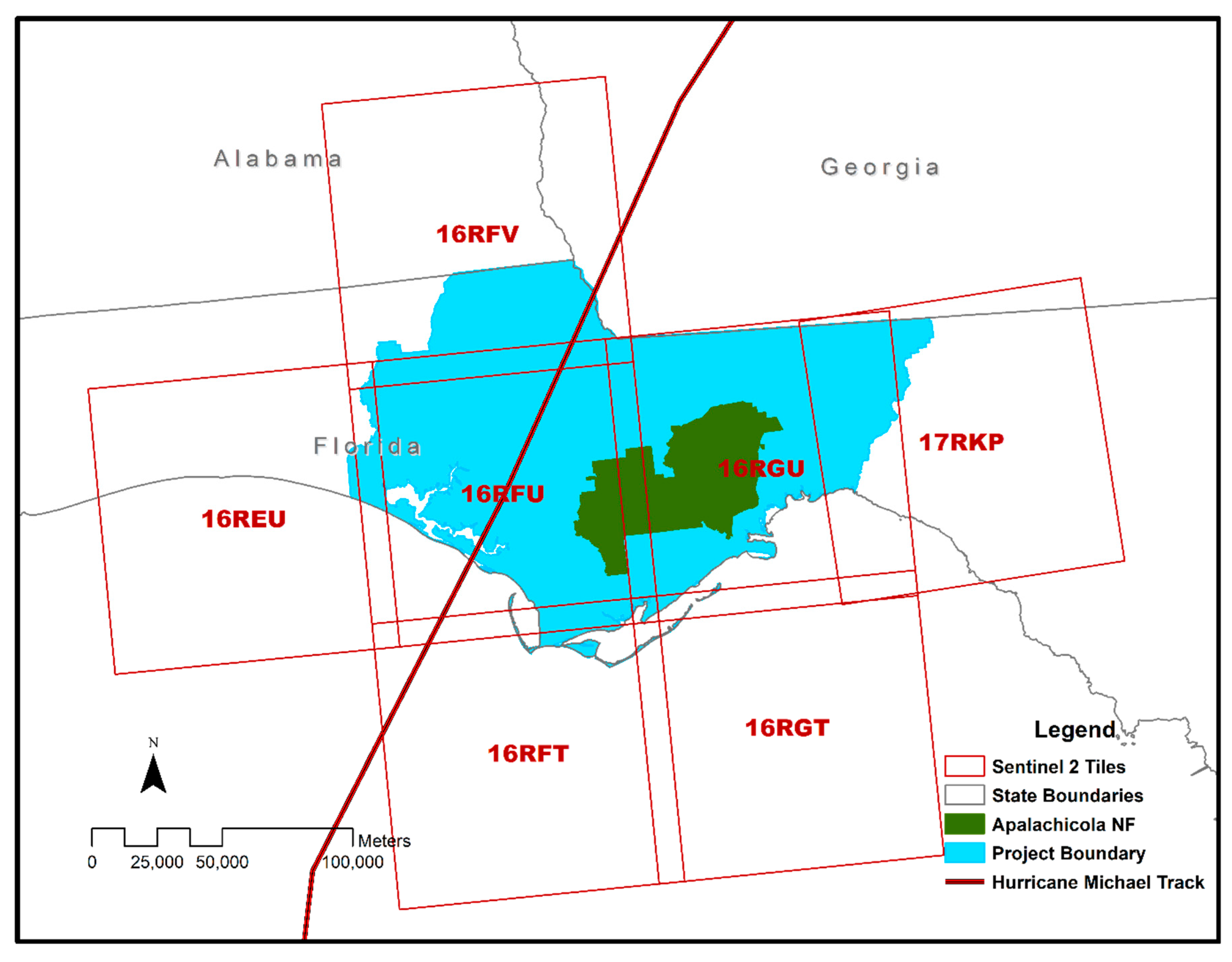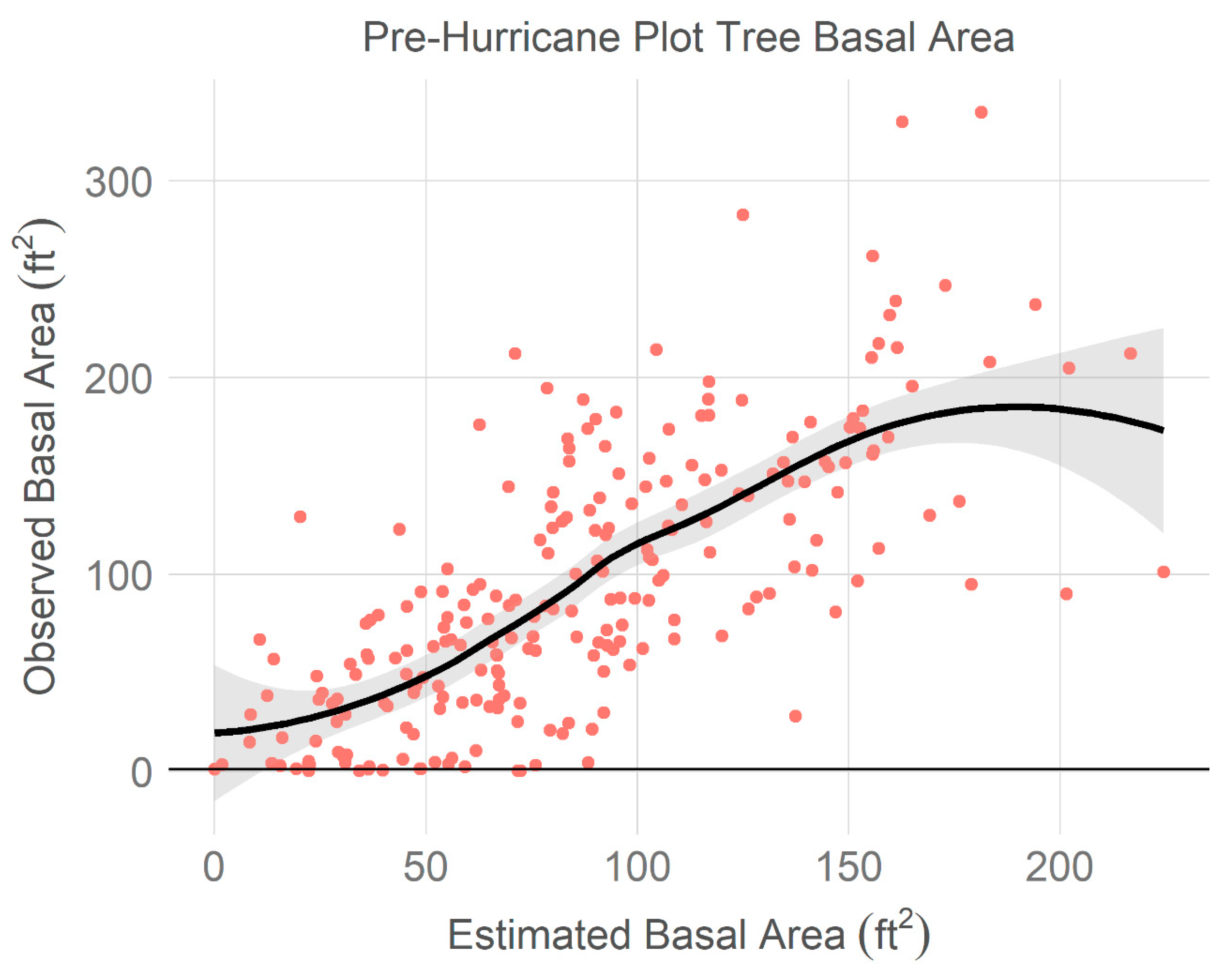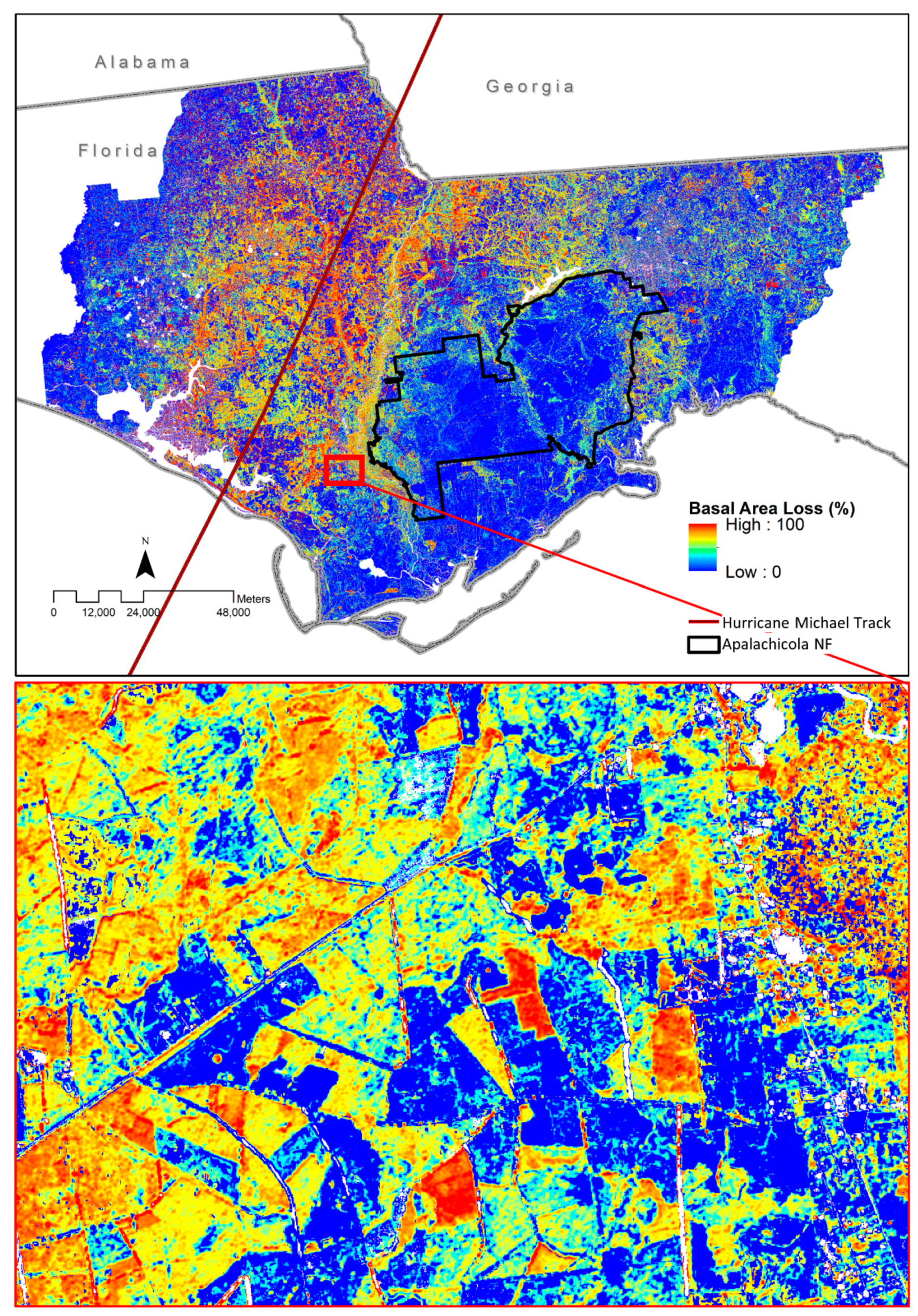Spatially Quantifying Forest Loss at Landscape-scale Following a Major Storm Event
Abstract
1. Introduction
2. Methods
2.1. Study Area
2.2. Datasets
2.2.1. Restore Plots
2.2.2. Imagery
2.3. Imagery Preprocessing
Principal Component Analysis
2.4. Model Development
3. Results
3.1. PCA Results
3.2. Basal Area Model Results
3.3. Spatial Basal Area Raster Results
4. Discussion
5. Conclusions
Author Contributions
Funding
Conflicts of Interest
Appendix A
| Pre-Hurricane Senescence | |||
| Tile | Date | Normalized to | Mosaic Order |
| T16RFU | 1/30/2018 | 1 | |
| T16REU | 1/30/2018 | T16RFU | 2 |
| T16RFV | 1/30/2018 | T16RFU | 3 |
| T16RGU | 12/13/2017 | T16RFU | 4 |
| T17RKP | 12/13/2017 | T16RGU | 5 |
| T16RGT | 12/13/2017 | T16RFU | 6 |
| T16RFT | 1/30/2018 | T16RFU | 7 |
| Pre-Hurricane Growing | |||
| Tile | Date | Normalized to | Mosaic Order |
| T16RFU | 4/30/2108 | 1 | |
| T16REU | 3/31/2018 | T16RFU | 2 |
| T16RFV | 4/20/2018 | T16RFU | 3 |
| T16RGU | 4/17/2018 | T16RFU | 4 |
| T17RKP | 4/17/2018 | T16RGU | 5 |
| T16RFT | 4/17/2018 | T16RFU | 6 |
| T16RGT | 4/12/2018 | T16RFU | 7 |
| Post-Hurricane Senescence | |||
| Tile | Date | Normalized to | Mosaic Order |
| T16RFU | 1/25/2019 | 1 | |
| T16REU | 1/10/2019 | T16RFU | 2 |
| T16RFV | 1/10/2019 | T16RFU | 3 |
| T17RKP | 12/23/2018 | T16RGU | 4 |
| T16RGU | 1/7/2019 | T16RFU | 5 |
| T16RGT | 1/17/2019 | T16RFU | 6 |
| T16RFT | 1/10/2019 | T16RFU | 7 |
| Post-Hurricane Growing | |||
| Tile | Date | Normalized to | Mosaic Order |
| T16RFU | 4/15/2019 | 1 | |
| T16REU | 4/15/2019 | T16RFU | 2 |
| T16RFV | 4/15/2019 | T16RFU | 3 |
| T16RGU | 3/23/2019 | T16RFU | 4 |
| T17RKP | 3/23/2019 | T16RGU | 5 |
| T16RFT | 4/15/2019 | T16RFU | 6 |
| T16RGT | 3/23/2019 | T16RFU | 7 |
References
- Beven, J.L., II; Berg, R.; Hagen, A. Hurricane Michael. National Hurricane Center Tropical Cyclone Report. 2019. Available online: https://www.nhc.noaa.gov/data/tcr/AL142018_Michael.pdf (accessed on 2 September 2019).
- Zampieri, N.E.; Pau, S.; Okamoto, D.K. The impact of Hurricane Michael on longleaf pine habitats in Florida. bioRxiv Preprints 2019, 1–21. [Google Scholar] [CrossRef]
- Bender, M.A.; Knutson, T.R.; Tuleya, R.E.; Sirutis, J.J.; Vecchi, G.A.; Garner, S.T.; Held, I.M. Modeled Impact of Anthropogenic Warming on the Frequency of Intense Atlantic Hurricanes. Science 2010, 327, 454–458. [Google Scholar] [CrossRef] [PubMed]
- Seidl, R.; Thom, D.; Kautz, M.; Martin-Benito, D.; Peltoniemi, M.; Vacchiano, G.; Wild, J.; Ascoli, D.; Petr, M.; Honkaniemi, J.; et al. Forest disturbance under climate change. Nat. Clim. Chang. 2017, 7, 395–402. [Google Scholar] [CrossRef] [PubMed]
- Dale, V.H.; Joyce, L.A.; McNulty, S.; Neilson, R.P.; Ayres, M.P.; Flannigan, M.D.; Wotton, B.M. Climate Change and Forest Disturbances: Climate change can affect forests by altering the frequency, intensity, duration, and timing of fire, drought, introduced species, insect and pathogen outbreaks, hurricanes, windstorms, ice storms, or landslides. BioScience 2001, 51, 723–734. [Google Scholar] [CrossRef]
- Wang, W.; Qu, J.J.; Hao, X.; Liu, Y.; Stanturf, J.A. Post-hurricane forest damage assessment using satellite remote sensing. Agric. For. Meteorol. 2010, 150, 122–132. [Google Scholar] [CrossRef]
- Hu, T.; Smith, R.B. The Impact of Hurricane Maria on the Vegetation of Dominica and Puerto Rico Using Multispectral Remote Sensing. Remote Sens. 2018, 10, 827. [Google Scholar] [CrossRef]
- Lee, M.-F.; Lin, T.-C.; Vadeboncoeur, M.A.; Hwong, J.-L. Remote sensing assessment of foret damage in relation to the 1996 strong typhoon Herb at Lienhuachi Experimental Forest, Taiwan. For. Ecol. Manag. 2008, 255, 3297–3306. [Google Scholar] [CrossRef]
- Parker, G.; Martínez-Yrízar, A.; Álvarez-Yépiz, J.C.; Maass, M.; Araiza, S. Effects of hurricane distrubance on a tropical dry forest canopy in western Mexico. For. Ecol. Manag. 2018, 426, 39–52. [Google Scholar] [CrossRef]
- Ramsey, E.W., III; Hodgson, M.E.; Sapkota, S.K.; Nelson, G.A. Forest impact estimated with NOAA AVHRR and Landsat TM data related to an empirical hurricane wind-field distribution. Remote Sens. Environ. 2001, 77, 279–292. [Google Scholar] [CrossRef]
- Rossi, E.; Rogan, J.; Schneider, L. Mapping forest damage in northern Nicaragua after Hurricane Felix (2007) using MODIS enhanced vegetation index data. GISci. Remote Sens. 2013, 50, 385–399. [Google Scholar] [CrossRef]
- Zhang, X.; Friedl, M.A.; Schaaf, C.B.; Strahler, A.H.; Hodges, J.C.; Gao, F.; Huete, A. Monitoring vegetation phenology using MODIS. Remote Sens. Environ. 2003, 84, 471–475. [Google Scholar] [CrossRef]
- Chambers, J.Q.; Fisher, J.I.; Zeng, H.; Chapman, E.L.; Baker, D.B.; Hurtt, G.C. Hurricane Katrina’s Carbon Footprint on U.S. Gulf Coast Forests. Science 2007, 318, 1107. [Google Scholar] [CrossRef] [PubMed]
- Negrón-Juárez, R.; Baker, D.B.; Chambers, J.Q.; Hurtt, G.C.; Goosem, S. Multi-scale sensitivity of Landsat and MODIS to forest distrubance associated with tropical cyclones. Remote Sens. Environ. 2014, 140, 679–689. [Google Scholar] [CrossRef]
- Aosier, B.; Kaneko, M.; Takada, M. Evaluation of The Forest Damage by Typhoon Using Remote Sensing Technique. In Proceedings of the 2007 IEEE International Geoscience and Remote Sensing Symposium, Barcelona, Spain, 23–28 July 2007; IEEE: Piscataway, NJ, USA, 2007; pp. 3022–3026. [Google Scholar] [CrossRef]
- Hodgson, M.E.; Davis, B.A.; Cheng, Y.; Miller, J. Modeling Remote Sensing Satellite Collection Opportunity Likelihood for Hurricane Disaster Response. Cartogr. Geogr. Inf. Sci. 2010, 37, 7–15. [Google Scholar] [CrossRef]
- Hogland, J.; Anderson, N.; Affleck, D.L.; St. Peter, J. Using Forest Inventory Data with Landsat 8 Imagery to Map Longleaf Pine Forest Characteristics in Georgia, USA. Remote Sens. 2019, 11, 1803. [Google Scholar] [CrossRef]
- Hogland, J.; Anderson, N.; St. Peter, J.; Drake, J.; Medley, P. Mapping Forest Characteristics at Fine Resolution across Large Landscapes of the Southeastern United States Using NAIP Imagery and FIA Field Plot Data. Int. J. Geo-Inf. 2018, 7, 140. [Google Scholar] [CrossRef]
- Hogland, J.; Affleck, D.L. Mitigating the Impact of Field and Image Registration Errors through Spatial Aggregation. Remote Sens. 2019, 11, 222. [Google Scholar] [CrossRef]
- Flynn, D.F.; Uriarte, M.; Crk, T.; Pascarella, J.B.; Zimmerman, J.K.; Aide, T.M.; Caraballo Ortiz, M.A. Hurricane Disturbance Alters Secondary Forest Recovery in Puerto Rico. Biotropica 2010, 42, 149–157. [Google Scholar] [CrossRef]
- Stein, B.A.; Kutner, L.S.; Adams, J.S. Precious Heritage: The Status of Biodiversity in the United States; Oxford University Press: New York, NY, USA, 2000. [Google Scholar]
- Noss, R.F. The longleaf pine landscape of the Southeast: Almost gone and almost forgotten. Endanger. Species Update 1988, 5, 55. [Google Scholar]
- Noss, R.F. Longleaf pine and wiregrass: Keystone components of an endangered Ecosystem. Nat. Areas J. 1989, 9, 211–213. [Google Scholar]
- Florida Natural Areas Inventory 2004. Natural Communities and Habitats. Forested Wetlands. ARROW. Available online: https://www.fnai.org/ARROW/Almanac/biology/biology_wetlands.cfm (accessed on 16 September 2019).
- Clerc, S.; Team, M. Sentinel-2 Data Quality Report, Technical Report 44, S2-PDGS-MPC-DQR. France: ESA-CS. 2019. Available online: https://sentinel.esa.int/documents/247904/685211/Sentinel-2_L1C_Data_Quality_Report (accessed on 20 November 2019).
- Gascon, F.; Bouzinac, C.; Thépaut, O.; Jung, M.; Francesconi, B.; Louis, J.; Fernandez, V. Copernicus Sentinel-2A Calibration and Products Validation Status. Remote Sens. 2017, 9, 584. [Google Scholar] [CrossRef]
- U.S. Geological Survey. Earth Explorer. Available online: https://earthexplorer.usgs.gov (accessed on 16 February 2019).
- National Hurricane Center. NHC Data Archive. Available online: https://www.nhc.noaa.gov/data/ (accessed on 4 March 2019).
- Hogland, J. Creating Spatial Probability Distributions for Longleaf Pine Ecosystems Across East Mississippi, Alabama, The Panhandle of Florida and West Georgia. Master’s Thesis, Auburn University, Auburn, AL, USA, 2005. [Google Scholar]
- R Core Team. R: A Language and Environment for Statistical Computing; R Foundation for Statistical Computing: Vienna, Austria, 2019; Available online: www.R-project.org (accessed on 21 January 2019).
- U.S. Forest Service, Rocky Mountain Research Station. RMRS Raster Utility. Available online: http://www.fs.fed.us/rm/raster-utility (accessed on 16 February 2019).
- St. Peter, J.; Hogland, J.; Anderson, N.; Drake, J.; Medley, P. Fine resolution probabilistic land cover classification of landscapes in the southeastern United States. ISPRS Int. J. Geo-Inf. 2018, 7, 107. [Google Scholar] [CrossRef]
- Coulter, L.L.; Stow, D.A. Assessment of the Spatial Co-registration of Multitemporal Imagery from Large Format Digital Cameras in the Context of Detailed Change Detection. Sensors 2008, 8, 2161–2173. [Google Scholar] [CrossRef] [PubMed]
- Eastman, R.D.; Le Moigne, J.; Netanyahu, N.S. Research issues in image registration for remote sensing. In Proceedings of the 2007 IEEE Conference on Computer Vision and Pattern Recognition, Minneapolis, MN, USA, 17–22 June 2007; IEEE: Piscataway, NJ, USA, 2007. [Google Scholar] [CrossRef]
- Walker, L.R. Timing of post-hurricane tree mortality in Puerto Rico. J. Trop. Ecol. 1995, 11, 315–320. [Google Scholar] [CrossRef]
- Everham, E.M.; Brokaw, N.V.L. Forest damage and recovery from catastrophic wind. Bot. Rev. 1996, 62, 113–185. [Google Scholar] [CrossRef]
- Henkel, T.K.; Chambers, J.Q.; Baker, D.A. Delayed tree mortality and Chinese tallow (Triadica sebifera) population expolosion in a Louisiana bottomland hardwood forest following Hurricane Katrina. For. Ecol. Manag. 2016, 15, 222–232. [Google Scholar] [CrossRef]
- Liu, S.; Hodgson, M.E. Optimizing large area coverage from multiple satellite-sensors. GISci. Remote Sens. 2013, 50, 652–666. [Google Scholar] [CrossRef]
- Scheffler, D.; Hollstein, A.; Diedrich, H.; Segl, K.; Hostert, P. AROSICS: An Automated and Robust Open-Source Image Co-Registration Software for Multi-Sensor Satellite Data. Remote Sens. 2017, 9, 676. [Google Scholar] [CrossRef]
- St. Peter, J.; Anderson, C.; Drake, J.; Medley, P. Spatially Quantifying Forest Damage from a Category 5 Hurricane, v2, Dryad, Dataset. 2019. Available online: https://doi.org/10.5061/dryad.905qfttgc (accessed on 17 December 2019).






| Area Size (Hectares) | Avg. BA Loss (m2/hectare) | 95% CI (m2/hectare) | Total BA Loss (m2) | 95% CI (m2) | Percent BA Loss | |
|---|---|---|---|---|---|---|
| Project Area | 1,900,773 | 73.2 | 63.7-82.6 | 7,328,640 | 6,383,549 - 8,273,731 | 19.18% |
| ANF | 254,199 | 29.3 | 25.5-33.1 | 392,204 | 341,626 - 442,782 | 7.67% |
| Hurricane | 1,146,405 | 90.0 | 78.4-101.6 | 5,435,244 | 4,734,323 - 6,136,165 | 28.01% |
| Tropical Storm | 674,434 | 46.6 | 40.6-52.7 | 1,657,659 | 1,443,890 - 1,871,428 | 13.16% |
| Reference | |||
|---|---|---|---|
| Predicted | Heavy | Medium | Light |
| Heavy | 3 | 5 | 2 |
| Medium | 1 | 2 | 7 |
| Light | 0 | 4 | 45 |
| Accuracy | 0.72 | ||
© 2020 by the authors. Licensee MDPI, Basel, Switzerland. This article is an open access article distributed under the terms and conditions of the Creative Commons Attribution (CC BY) license (http://creativecommons.org/licenses/by/4.0/).
Share and Cite
St. Peter, J.; Anderson, C.; Drake, J.; Medley, P. Spatially Quantifying Forest Loss at Landscape-scale Following a Major Storm Event. Remote Sens. 2020, 12, 1138. https://doi.org/10.3390/rs12071138
St. Peter J, Anderson C, Drake J, Medley P. Spatially Quantifying Forest Loss at Landscape-scale Following a Major Storm Event. Remote Sensing. 2020; 12(7):1138. https://doi.org/10.3390/rs12071138
Chicago/Turabian StyleSt. Peter, Joseph, Chad Anderson, Jason Drake, and Paul Medley. 2020. "Spatially Quantifying Forest Loss at Landscape-scale Following a Major Storm Event" Remote Sensing 12, no. 7: 1138. https://doi.org/10.3390/rs12071138
APA StyleSt. Peter, J., Anderson, C., Drake, J., & Medley, P. (2020). Spatially Quantifying Forest Loss at Landscape-scale Following a Major Storm Event. Remote Sensing, 12(7), 1138. https://doi.org/10.3390/rs12071138






